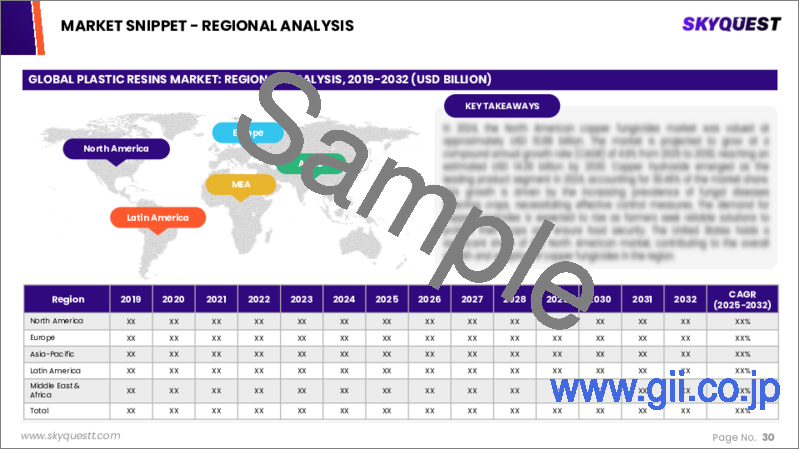|
|
市場調査レポート
商品コード
1643805
プラスチック樹脂の市場規模、シェア、成長分析:製品別、用途別、地域別 - 産業予測、2025年~2032年Plastic Resins Market Size, Share, Growth Analysis, By Product (Crystalline Resin, Non-crystalline Resin), By Application (Packaging, Automotive), By Region - Industry Forecast 2025-2032 |
||||||
|
|||||||
| プラスチック樹脂の市場規模、シェア、成長分析:製品別、用途別、地域別 - 産業予測、2025年~2032年 |
|
出版日: 2025年01月22日
発行: SkyQuest
ページ情報: 英文 255 Pages
納期: 3~5営業日
|
全表示
- 概要
- 目次
プラスチック樹脂の市場規模は、2023年に7,641億6,000万米ドルとなり、予測期間(2025年~2032年)のCAGRは4.5%で、2024年の7,985億5,000万米ドルから、2032年までには1兆1,356億1,000万米ドルに成長する見通しです。
市場の洞察によると、建設、自動車、電気・電子などの分野でプラスチック樹脂の需要が高まっていることが、大きな成長を後押ししています。特に自動車セクターは、軽量でコスト効率が高く、燃費の良い自動車への需要が高まっており、様々な部品へのプラスチック樹脂の使用を後押ししています。同時に、インドや中国のような新興市場は建設投資を活発化させており、インフラプロジェクトにおける樹脂需要の増加につながっています。さらに、持続可能性へのシフトは、リサイクルプラスチック樹脂の革新を企業に促し、市場競争力を高めています。NOVA Chemicalsが2022年10月に発売したメカニカルリサイクルポリエチレン樹脂「EX_PCR-NC4」はその顕著な例で、特にeコマースや保護用途において、包装性能を犠牲にすることなく持続可能性を達成することを可能にします。
目次
イントロダクション
- 調査の目的
- 調査範囲
- 定義
調査手法
- 情報調達
- 二次データと一次データの方法
- 市場規模予測
- 市場の前提条件と制限
エグゼクティブサマリー
- 世界市場の見通し
- 供給と需要の動向分析
- セグメント別機会分析
市場力学と見通し
- 市場概要
- 市場規模
- 市場力学
- 促進要因と機会
- 抑制要因と課題
- ポーターの分析
主要な市場の考察
- 主要な成功要因
- 競合の程度
- 主要な投資機会
- 市場エコシステム
- 市場の魅力指数(2024年)
- PESTEL分析
- マクロ経済指標
- バリューチェーン分析
- 価格分析
- 規制分析
- 特許分析
世界のプラスチック樹脂の市場規模:製品別・CAGR(2025年~2032年)
- 市場概要
- 結晶性樹脂
- エポキシ
- ポリエチレン
- ポリプロピレン
- 非結晶性樹脂
- ポリ塩化ビニル(PVC)
- ポリスチレン(PS)
- アクリロニトリルブタジエンスチレン(ABS)
- ポリメチルメタクリレート(PMMA)
- エンジニアリングプラスチック
- ナイロン
- ポリブチレンテレフタレート(PBT)
- ポリカーボネート(PC)
- ポリアミド
- スーパーエンジニアリングプラスチック
- ポリフェニレンサルファイド(PPS)
- ポリエーテルエーテルケトン(PEEK)
- 液晶ポリマー(LCP)
世界のプラスチック樹脂の市場規模:用途別・CAGR(2025年~2032年)
- 市場概要
- 包装
- 食品
- 飲料
- 医療
- 小売り
- その他
- 自動車
- 建設
- 電気・電子
- OA機器・家電
- 電子材料
- その他
- ロジスティクス
- 消費財
- 繊維・衣料
- 衣類
- 工業用途
- その他
- 家具・寝具
- 農業
- 医療機器
- その他
世界のプラスチック樹脂の市場規模・CAGR(2025年~2032年)
- 北米
- 米国
- カナダ
- 欧州
- ドイツ
- スペイン
- フランス
- 英国
- イタリア
- その他欧州地域
- アジア太平洋
- 中国
- インド
- 日本
- 韓国
- その他アジア太平洋
- ラテンアメリカ
- ブラジル
- その他ラテンアメリカ地域
- 中東・アフリカ
- GCC諸国
- 南アフリカ
- その他中東・アフリカ
競合情報
- 上位5社の比較
- 主要企業の市場ポジショニング(2024年)
- 主な市場企業が採用した戦略
- 市場の最近の動向
- 企業の市場シェア分析(2024年)
- 主要企業の企業プロファイル
- 会社概要
- 製品ポートフォリオ分析
- 企業のセグメント別シェア分析
- 収益の前年比比較(2022年~2024年)
主要企業プロファイル
- LyondellBasell Industries N.V.(Netherlands)
- Formosa Plastics Corporation(Taiwan)
- Braskem S.A.(Brazil)
- Trinseo S.A.(United States)
- Amcor plc(Australia)
- Berry Global Group, Inc.(United States)
- ExxonMobil Chemical Company(United States)
- SABIC(Saudi Basic Industries Corporation)(Saudi Arabia)
- Dow Inc.(United States)
- BASF SE(Germany)
- INEOS Group Holdings S.A.(United Kingdom)
- TotalEnergies SE(France)
- LG Chem Ltd.(South Korea)
- Chevron Phillips Chemical Company LLC(United States)
- Reliance Industries Limited(India)
- Mitsubishi Chemical Corporation(Japan)
- Sumitomo Chemical Co., Ltd.(Japan)
- Lotte Chemical Corporation(South Korea)
- Westlake Chemical Corporation(United States)
- Sinopec Limited(China)
結論と提言
Plastic Resins Market size was valued at USD 764.16 billion in 2023 and is poised to grow from USD 798.55 billion in 2024 to USD 1135.61 billion by 2032, growing at a CAGR of 4.5% during the forecast period (2025-2032).
Market insights indicate that the escalating demand for plastic resins across sectors like construction, automotive, and electrical & electronics is propelling significant growth. The automotive sector, in particular, is thriving, with heightened demand for lightweight, cost-effective, and fuel-efficient vehicles, thereby boosting plastic resin usage in various components. Concurrently, emerging markets like India and China are ramping up construction investments, leading to increased demand for resins in infrastructure projects. Furthermore, the shift towards sustainability is driving companies to innovate in recycled plastic resins, enhancing market competitiveness. A notable example is NOVA Chemicals' introduction of EX_PCR-NC4, a mechanically recycled polyethylene resin launched in October 2022, enabling manufacturers to achieve sustainability without sacrificing packaging performance, particularly for e-commerce and protective applications.
Top-down and bottom-up approaches were used to estimate and validate the size of the Plastic Resins market and to estimate the size of various other dependent submarkets. The research methodology used to estimate the market size includes the following details: The key players in the market were identified through secondary research, and their market shares in the respective regions were determined through primary and secondary research. This entire procedure includes the study of the annual and financial reports of the top market players and extensive interviews for key insights from industry leaders such as CEOs, VPs, directors, and marketing executives. All percentage shares split, and breakdowns were determined using secondary sources and verified through Primary sources. All possible parameters that affect the markets covered in this research study have been accounted for, viewed in extensive detail, verified through primary research, and analyzed to get the final quantitative and qualitative data.
Plastic Resins Market Segments Analysis
Global Plastic Resins Market is segmented by Product, Application and region. Based on Product, the market is segmented into Crystalline Resin, Non-crystalline Resin, Engineering Plastic and Super Engineering Plastic. Based on Application, the market is segmented into Packaging, Automotive, Construction, Electrical & Electronics, Logistics, Consumer Goods, Textiles & Clothing, Furniture & Bedding, Agriculture, Medical Devices and Others. Based on region, the market is segmented into North America, Europe, Asia Pacific, Latin America and Middle East & Africa.
Driver of the Plastic Resins Market
The Plastic Resins market is significantly driven by the rising demand from various end-use industries, particularly the automotive and construction sectors. In the automotive industry, the utilization of plastic contributes to reducing vehicle weight and density, thereby improving fuel efficiency; plastic resins are essential in manufacturing components such as seat cushions, suspension parts, and wheels. Additionally, the shift towards electric vehicle production reflects increasing consumer awareness, further propelling market growth. Simultaneously, the construction industry's reliance on plastic resins for both residential and commercial structures has surged, fueled by rapid urbanization and population growth in emerging markets, prompting governmental investments in infrastructure development.
Restraints in the Plastic Resins Market
One significant restraint in the plastic resins market is the volatility of raw material prices, which include essential substances like natural gas, crude oil, coal, salt, and sand. In North America, the production of polyethylene is heavily dependent on local natural gas supplies, which are both abundant and inexpensive, resulting in a highly competitive environment among manufacturers and a tight resins market that supports substantial exports. However, fluctuating crude oil prices, influenced by factors such as political instability, supply-demand dynamics, and seasonal changes, pose challenges. In response, leading companies are forming strategic alliances and expanding production capacities to accommodate the surging global demand while benefiting from lower feedstock costs.
Market Trends of the Plastic Resins Market
The Plastic Resins market is witnessing a significant trend toward sustainability, driven largely by technological advancements in bioplastics. Bioplastics, such as PLA (polylactic acid), PHA (Polyhydroxyalkanoates), and CPLA (crystalized PLA), are gaining traction due to their renewable biomass sourcing and environment-friendly properties. This shift is driven by heightened consumer and regulatory demand for sustainable alternatives to traditional petroleum-based resins. With the growing emphasis on biodegradability, recyclability, and compostability, manufacturers are increasingly investing in bioplastic technologies, positioning themselves to meet the evolving preferences of environmentally conscious consumers and to comply with stringent regulations aimed at reducing plastic waste.
Table of Contents
Introduction
- Objectives of the Study
- Scope of the Report
- Definitions
Research Methodology
- Information Procurement
- Secondary & Primary Data Methods
- Market Size Estimation
- Market Assumptions & Limitations
Executive Summary
- Global Market Outlook
- Supply & Demand Trend Analysis
- Segmental Opportunity Analysis
Market Dynamics & Outlook
- Market Overview
- Market Size
- Market Dynamics
- Drivers & Opportunities
- Restraints & Challenges
- Porters Analysis
- Competitive rivalry
- Threat of substitute
- Bargaining power of buyers
- Threat of new entrants
- Bargaining power of suppliers
Key Market Insights
- Key Success Factors
- Degree of Competition
- Top Investment Pockets
- Market Ecosystem
- Market Attractiveness Index, 2024
- PESTEL Analysis
- Macro-Economic Indicators
- Value Chain Analysis
- Pricing Analysis
- Regulatory Analysis
- Patent Analysis
Global Plastic Resins Market Size by Product & CAGR (2025-2032)
- Market Overview
- Crystalline Resin
- Epoxy
- Polyethylene
- Polypropylene
- Non-crystalline Resin
- Polyvinyl Chloride (PVC)
- Polystyrene (PS)
- Acrylonitrile Butadiene Styrene (ABS)
- Polymethyl Methacrylate (PMMA)
- Engineering Plastic
- Nylon
- Polybutylene Terephthalate (PBT)
- Polycarbonate (PC)
- Polyamide
- Super Engineering Plastic
- Polyphenylene Sulfide (PPS)
- Polyether Ether Ketone (PEEK)
- Liquid Crystal Polymer (LCP)
Global Plastic Resins Market Size by Application & CAGR (2025-2032)
- Market Overview
- Packaging
- Food
- Beverage
- Medical
- Retail
- Others
- Automotive
- Construction
- Electrical & Electronics
- OA Equipment & Home Appliances
- Electronic Materials
- Others
- Logistics
- Consumer Goods
- Textiles & Clothing
- Clothing
- Industrial use
- Others
- Furniture & Bedding
- Agriculture
- Medical Devices
- Others
Global Plastic Resins Market Size & CAGR (2025-2032)
- North America (Product, Application)
- US
- Canada
- Europe (Product, Application)
- Germany
- Spain
- France
- UK
- Italy
- Rest of Europe
- Asia Pacific (Product, Application)
- China
- India
- Japan
- South Korea
- Rest of Asia-Pacific
- Latin America (Product, Application)
- Brazil
- Rest of Latin America
- Middle East & Africa (Product, Application)
- GCC Countries
- South Africa
- Rest of Middle East & Africa
Competitive Intelligence
- Top 5 Player Comparison
- Market Positioning of Key Players, 2024
- Strategies Adopted by Key Market Players
- Recent Developments in the Market
- Company Market Share Analysis, 2024
- Company Profiles of All Key Players
- Company Details
- Product Portfolio Analysis
- Company's Segmental Share Analysis
- Revenue Y-O-Y Comparison (2022-2024)
Key Company Profiles
- LyondellBasell Industries N.V. (Netherlands)
- Company Overview
- Business Segment Overview
- Financial Updates
- Key Developments
- Formosa Plastics Corporation (Taiwan)
- Company Overview
- Business Segment Overview
- Financial Updates
- Key Developments
- Braskem S.A. (Brazil)
- Company Overview
- Business Segment Overview
- Financial Updates
- Key Developments
- Trinseo S.A. (United States)
- Company Overview
- Business Segment Overview
- Financial Updates
- Key Developments
- Amcor plc (Australia)
- Company Overview
- Business Segment Overview
- Financial Updates
- Key Developments
- Berry Global Group, Inc. (United States)
- Company Overview
- Business Segment Overview
- Financial Updates
- Key Developments
- ExxonMobil Chemical Company (United States)
- Company Overview
- Business Segment Overview
- Financial Updates
- Key Developments
- SABIC (Saudi Basic Industries Corporation) (Saudi Arabia)
- Company Overview
- Business Segment Overview
- Financial Updates
- Key Developments
- Dow Inc. (United States)
- Company Overview
- Business Segment Overview
- Financial Updates
- Key Developments
- BASF SE (Germany)
- Company Overview
- Business Segment Overview
- Financial Updates
- Key Developments
- INEOS Group Holdings S.A. (United Kingdom)
- Company Overview
- Business Segment Overview
- Financial Updates
- Key Developments
- TotalEnergies SE (France)
- Company Overview
- Business Segment Overview
- Financial Updates
- Key Developments
- LG Chem Ltd. (South Korea)
- Company Overview
- Business Segment Overview
- Financial Updates
- Key Developments
- Chevron Phillips Chemical Company LLC (United States)
- Company Overview
- Business Segment Overview
- Financial Updates
- Key Developments
- Reliance Industries Limited (India)
- Company Overview
- Business Segment Overview
- Financial Updates
- Key Developments
- Mitsubishi Chemical Corporation (Japan)
- Company Overview
- Business Segment Overview
- Financial Updates
- Key Developments
- Sumitomo Chemical Co., Ltd. (Japan)
- Company Overview
- Business Segment Overview
- Financial Updates
- Key Developments
- Lotte Chemical Corporation (South Korea)
- Company Overview
- Business Segment Overview
- Financial Updates
- Key Developments
- Westlake Chemical Corporation (United States)
- Company Overview
- Business Segment Overview
- Financial Updates
- Key Developments
- Sinopec Limited (China)
- Company Overview
- Business Segment Overview
- Financial Updates
- Key Developments






